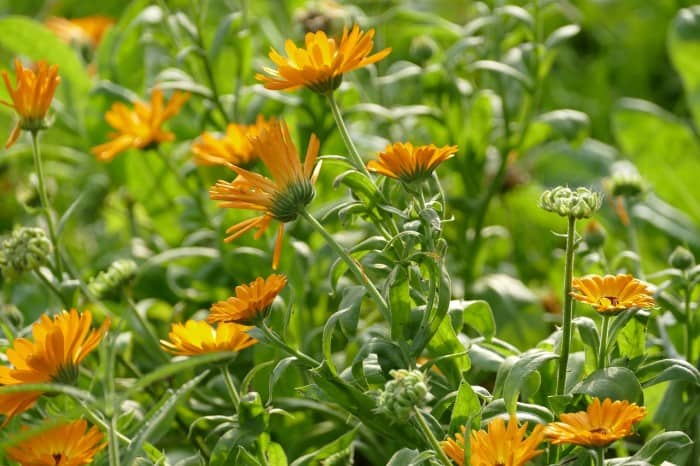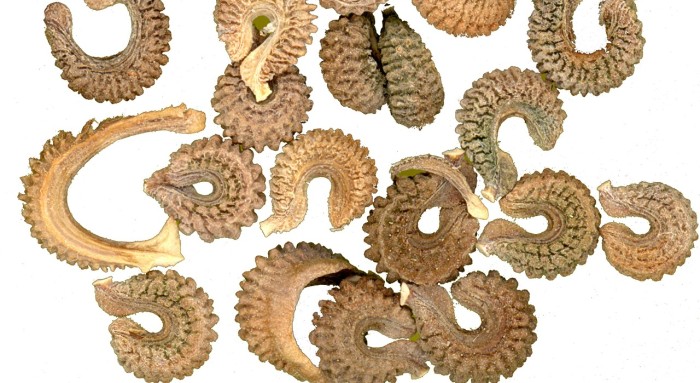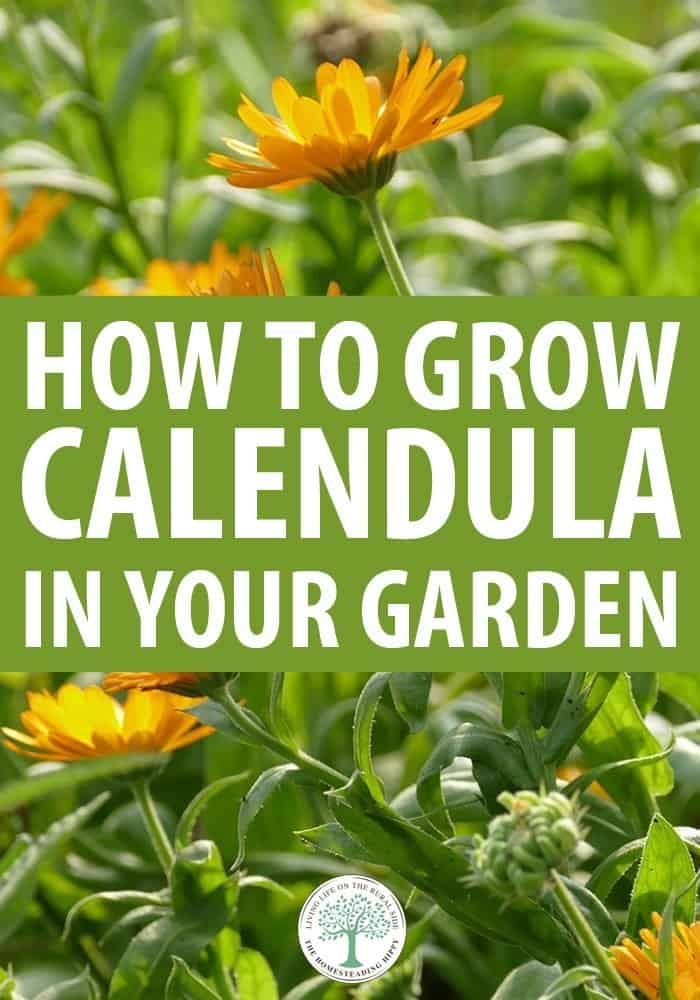With multiple medicinal and culinary uses, calendula is a popular plant known for its bright yellow and orange flowers. This gorgeous bloom follows the direction of the sun throughout the day, just like sunflowers, and offers a sunny addition to any home garden.

Also known as English marigolds or pot marigolds, these plants are known for their ability to repel a number of pests and to provide great benefits when planted with certain plants like tomatoes and asparagus.
These flowers provide a spectacular display of color from early summer until the first frost. They work well in patio planters or when used as part of a mixed border species.
Calendula is technically a flowering herb, and is an annual that will readily reseed if given the proper conditions. One of the interesting features of this plant is its resiliency – too much attention and care (notably, through over-fertilizing and over-pruning) can cause its growth to be stunted.
In this article we’re going to talk about growing calendula, starting it from seeds, cooking it, and a lot more.
Table of Contents
What Conditions Does Calendula Prefer?
Calendulas, or Calendula officinalisi, are easy to grow, requiring very little expertise or extensive care. They like to be planted in full sun or partial shade, and can grow in zones 2 through 10. This range of temperature tolerances makes them a great choice for any garden, as they can tolerate cool as well as warmer weather patterns.
Calendula prefers average, well-draining soil and doesn’t need much in the way of watering (although occasional watering is recommended). It is adaptable, and doesn’t need much maintenance, with roots adapting well to the space they are given. Calendula prefers cooler temperatures, with flowers lasting longer in lightly shaded areas.
Preparing the Soil
Calendula plants need rich soil or potting soil to develop. The best place to plant it is in a prepared garden bed or a large container filled with nutrient-dense potting soil. If this is not an option, simply work aged manure or compost into the ground to improve the conditions of your soil about a month before you are ready to plant.
Calendulas don’t require special soil, but they do like to receive full sun. You need to make sure the space you are planting them in is in direct sunlight for most of the day, and also is not prone to becoming waterlogged by heavy rains.
Try to create soil that has an average pH of 5.5-7.0. As you can see, a neutral pH is preferred. If you are unsure of your soil’s pH, consider conducting a basic soil test. For overly alkaline soil, consider adding acidic materials, like sphagnum peat, sulfur, or iron sulfate. You can also add acidifying nitrate. If your soil is too acidic, add materials like wood ash. Do this well ahead of planting, so that there is plenty of time for the matter to settle.

Starting Seeds
While calendula is easiest to grow from direct sowing, these plants can also be started indoors if you struggle with inconsistent weather. If you choose this option, seed them about eight weeks before the last anticipated frost date. Consider planting in flats to make transplanting easy. You should see seeds germinate in about five to fifteen days.
If you are planning on starting your seeds directly in the ground, plant them in early spring. If you live near the coast, you can plant them as soon as early February. If you want continual blooms, consider planting them consistently from late-February until early summer for a consistent crop.
Luckily, to plant calendula, you don’t need to wait until the danger of frost has passed, as these plants can tolerate a light frost and will actually thrive if they are exposed to one.
Plant seeds about ¼ inch to ½ inch deep. They can be sown about four to six inches apart and should be covered with an additional ¼ inch of garden soil.
Water the seedbed immediately after planting your seeds to help provide a boost of moisture. Keep the bed moist for the next week or so after planting, and don’t allow it to become dried out.
You must also take extra care not to wash the seeds away when you water. To ensure an even, gentle flow, use a sprayer nozzle with sprinkler adjustments instead of a full-strength garden hose.
As previously mentioned, you can plant calendula flowers anywhere you like, although containers or raised beds seem to work best. Many gardeners plant calendula in the flower or herb garden, as these plants add long lasting color to any setting.
Caring for Calendula Plants
At their largest, calendula plants will grow to be about 24 inches in height, so make sure you give them plenty of space when seeding or transplanting.
They take about sixty days to mature from seed to flower (under ideal conditions, often much less time than this) and should be planted with plenty of space between them to ensure they have room to sprawl.
You will need to deadhead your plants by pinching off spent flowers. This will help extend the blooming period. You should also fertilize occasionally to increase their blooms, ideally by using a liquid bloom fertilizer several times throughout the growing season.
Make sure you are water your plants thoroughly, giving them a good soaking about twice a week or more often during dry conditions.
Calendula plants don’t like to be soggy, but they can’t get dried out, either. Water the roots of the plant directly, and provide about an inch of moisture per week.
If you’re unsure how much water they are receiving naturally, consider installing a rainwater gauge.
A free, upcycled rainwater gauge can even be made out of an empty tuna can, which stands about an inch in height and can serve as a good indicator of how much rain you have received.
Another good rule of thumb is to consistently mulch your calendula. This will help prevent weeds and also allow the plants to retain moisture. In the heat of summer, mulch is essential to keep your roots cool, too.
While insects and diseases are typically not issues for calendula – in fact, the plant deters most pests – they can attract slugs. These can be treated by manually removing them, or by adding a slug bait. There are multiple chemical treatments you can use, or you can try a home remedy, such as a shallow dish of beer.
You don’t need to do much in the way of fertilizing throughout calendula’s growing season, but it’s not a bad idea to add some compost in midsummer. This will help replace any nutrients that the plants have depleted from the soil.
Compost is a great fertilizer, as it will provide a balanced source of nutrients without you having to worry about accidentally burning your developing plants. It may also provide a surge of blossoms when they are starting to naturally die back.
Otherwise, plant calendula in your garden to help keep pests away from your other plants. They are best planted with vegetables like carrots, chard, and tomatoes for the purpose of insect protection. Calendula can also repel harmful nematodes that live in the soil.
When your seedlings are about three inches in height, you should thin them. This will allow the remaining plants plenty of room to grow. This is not a mandatory step in caring for calendula plants, but is wise if you accidentally (or unknowingly) planted the seeds too closely together.
Culinary Uses for Calendula
In the kitchen, calendula flowers have been used historically for thousands of years. Because they were so easy to grow and in such ready supply, these flowers used to be a staple in British cottage gardens.
Upon harvesting their petals, British cooks would use them to flavor a variety of dishes, as well as to provide yellow coloring in cheese and butter. They can even be used in stews or broths to create a spicy taste that is second to none.
Calendula plants have edible flowers and leaves with a mild, spicy flavor. They add interesting flavor and zest to salads, pastas, and as garnishes alike.
Even better, they offer a number of benefits to your health. They can stimulate your immune system when ingested, and their flowers and leaves can both be eaten raw or saved for future use.
To preserve your calendula flowers or leaves, simply dehydrate them. They will last for several months in storage. Keeping them in storage can also help keep pests out of your precious food storage areas.
Wrap-Up
When your growing season has ended, consider saving the seeds of your calendula plants. These plants produce excessive amounts of seeds, and can be saved by first drying the blooms.
Let them dry, and then cut them off and hang them upside down in bundles. The seeds will gather in the heads and can be preserved once the plants are fully cured.
If you already have an herb or vegetable garden, or even just a large, bountiful flower garden, you should consider planting calendula next spring. This delightful annual herb provides colorful variety and a number of pest-repelling, health-promoting, and food-flavoring benefits to make it well worth your time.


Rebekah is a full-time homesteader. On her 22 acres, she raises chickens, sheep, and bees, not to mention she grows a wide variety of veggies. She has a huge greenhouse and does lots of DIY projects with her husband in her ever-growing homesteading endeavor. Learn more about Rebekah here.

What about deer? Are they deer resistant or do they need to bebin thevfenced garden?
Very helpful. Thank you so much!